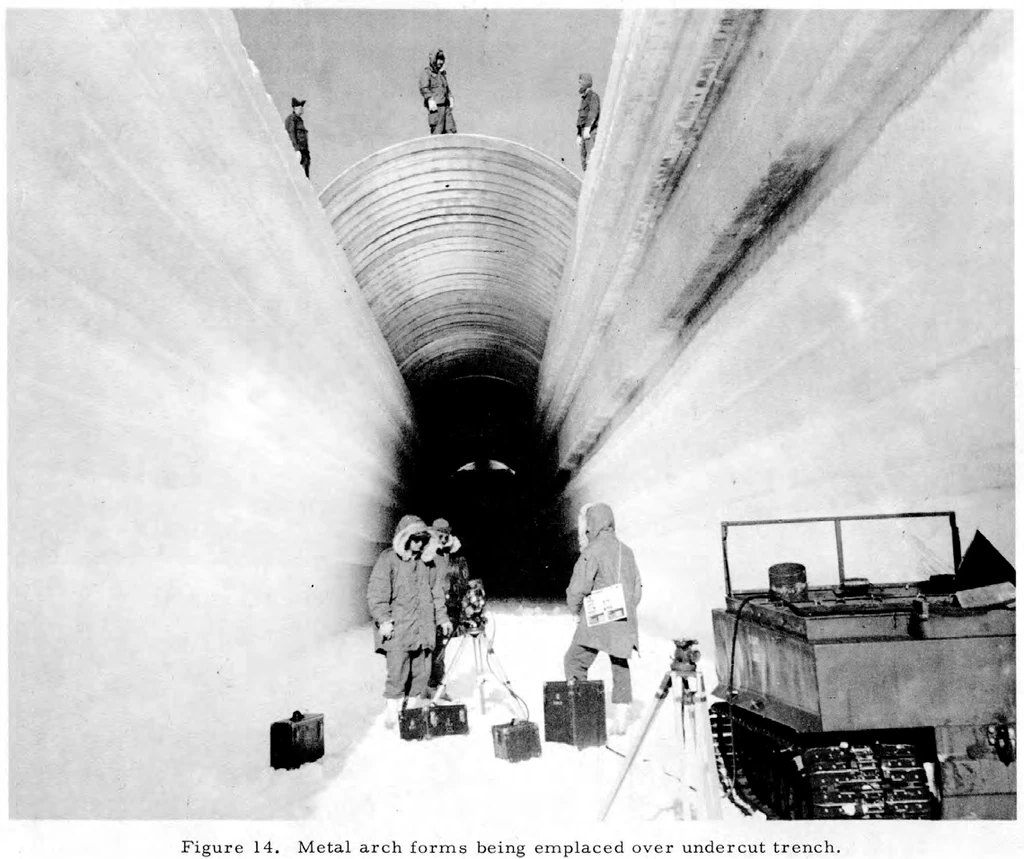The remains of Camp Century, a U.S. nuclear base constructed during the Cold War, have been discovered by a NASA team beneath the glaciers of Greenland.
The Wall Street Journal reported that the discovery was made in the spring of 2024 when scientists were testing a new radar system over northern Greenland and detected something peculiar. Several structures were interconnected by a network of tunnels deep within the ice sheet, resembling a frozen civilization that had been preserved in time. More specifically, the ice sheet carved 21 interconnected caverns spanning nearly three kilometers. A nuclear reactor powered this base, which had traveled over 210 kilometers across the glacier.
The base comprised latrines, laboratories, accommodations, a gym, and a mess hall that could accommodate approximately 200 military personnel.
This site was not the remnants of an ancient civilization; rather, it was a U.S. military base that formed part of the ambitious and clandestine Pentagon project known as “Project Iceworm.” The plan was to build a network of nuclear missile launch locations beneath the Arctic ice. The extent of U.S. involvement in Greenland over half a century ago was revealed by the underground site, which was designed to house 600 medium-range ballistic missiles, as noted by The Wall Street Journal.
The Pentagon publicly characterized the construction of Camp Century as an engineering achievement; however, its true purpose was kept secret, even from many of the men who served there. Only one woman, a Danish specialist, has visited the base.
Camp Century was partially built in 1959 and subsequently abandoned in 1967 due to the ice sheet’s inability to sustain the missile launch network. A minimum of 30 meters of accumulated ice currently submerges the structure. Some were aware of the base’s status as a research center before the NASA overflight, but the true military purpose remained a secret until 1996. In April of last year, Greene and his companions captured the first photograph of the site.

Camp Century is more than merely a Cold War relic. The straight-line distance between Greenland and Russia is subject to variation based on the specific locations, but it is typically approximately 5,000 kilometers (3,100 miles). For instance, the distance between the capital of Greenland, Nuuk, and the capital of Russia, Moscow, is approximately 4,650 kilometers (2,890 miles). The distances between other cities, such as Aasiaat in Greenland and Saint Petersburg in Russia, are slightly shorter, at approximately 3,966 kilometers (2,460 miles). In theory, a direct flight could take approximately 5.5 to 6 hours; however, the actual travel time is significantly prolonged due to the absence of direct routes and the necessity of layovers, frequently extending the journey to 15–24 hours or more.
The camp serves as a reminder of the long-standing U.S. presence on Danish territory in Greenland. Denmark was compelled to relinquish a portion of the territory to the United States to preserve its sovereignty over Greenland; however, President Donald Trump has pursued this objective even further. He criticized Denmark for failing to adequately defend Greenland, the world’s largest island, and even threatened to seize the territory by force in the name of U.S. national security.
Under a 1951 treaty with Denmark, the United States had the authority to establish bases in Greenland, which facilitated the construction of Camp Century. Camp Century was one of the 17 bases in Greenland that the United States maintained during the Cold War. Approximately 10,000 soldiers were stationed there. Currently, the Pituffik Space Base is home to fewer than 200 U.S. personnel.
The presence of U.S. nuclear weapons has historically precipitated friction with Denmark. The U.S. military did not inform Copenhagen, which had declared itself a nuclear-free zone, of Camp Century’s nuclear purpose at that time.
Since the start of World War II, Greenland has been a focal point in U.S. Arctic security analysis due to its mineral wealth. Greenland was a Danish colony during the occupation of Denmark by Nazi Germany in 1940. The United States was concerned that Germany might use the island as a base for military operations that were closer to the United States. The Danish representative in Washington signed an agreement in 1941 that transferred responsibility for Greenland’s defense to the United States. This agreement enabled Washington to establish bases on the island. After the conflict, the United States even proposed purchasing Greenland for $100 million; however, Denmark declined the offer. The Danish parliament ratified the 1941 treaty in 1951, allowing the U.S. to retain troops on the island.
The geographic position of Greenland is such that it is directly on the shortest route for Russian missiles targeting North America, particularly across the Arctic via the North Pole. Consequently, it is regarded as a prime location for basing missiles and early warning systems, rather than relying solely on the US mainland. This renders Greenland a crucial forward line of defense, enabling the United States to identify and potentially intercept incoming threats at a much earlier stage than would be feasible from the mainland. Advanced missile warning, space surveillance, and command and control functions are facilitated by the presence of installations such as the Pituffik Space Base (formerly Thule Air Base), which serves as a logistical center and strategic depth for Arctic operations. The location of Greenland also enables the United States and NATO to more effectively monitor and counter Russian military activities, which is particularly important in both deterrence and rapid response scenarios, as Russia has extensively militarized its own Arctic region.
